Research on Innovative Teaching Practice in Accounting Education
VerifiedAdded on 2023/06/11
|8
|2109
|366
Report
AI Summary
This report investigates the gap between accounting education and practice in India, employing a mixed-methods research design to explore the relationship between teacher quality, innovation, and graduate employment outcomes. It uses an abductive approach, gathering qualitative and quantitative data from final year students, accounting educators, fresh employees, employers, and professional bodies. The research employs convenience sampling to collect data through surveys and interviews, focusing on student performance (GPA) and stakeholder perspectives. Validity and reliability are ensured through pilot studies, frequency analysis, and Cronbach's alpha. Ethical considerations, including informed consent and confidentiality, are prioritized. Data analysis involves SPSS, ANOVA, T-tests, descriptive statistics, and Pearson Chi-Square tests to determine significant relationships. The study aims to define and measure teacher quality and innovation and find links between these factors and graduate employment outcomes in accounting education in India.

INNOVATIVE TEACHING PRACTICE IN ACCOUNTING EDUCATION1
INNOVATIVE TEACHING PRACTICE IN ACCOUNTING EDUCATION
Name:
Course:
Instructor:
Institution:
City (State)
Date:
INNOVATIVE TEACHING PRACTICE IN ACCOUNTING EDUCATION
INNOVATIVE TEACHING PRACTICE IN ACCOUNTING EDUCATION
Name:
Course:
Instructor:
Institution:
City (State)
Date:
INNOVATIVE TEACHING PRACTICE IN ACCOUNTING EDUCATION
Paraphrase This Document
Need a fresh take? Get an instant paraphrase of this document with our AI Paraphraser
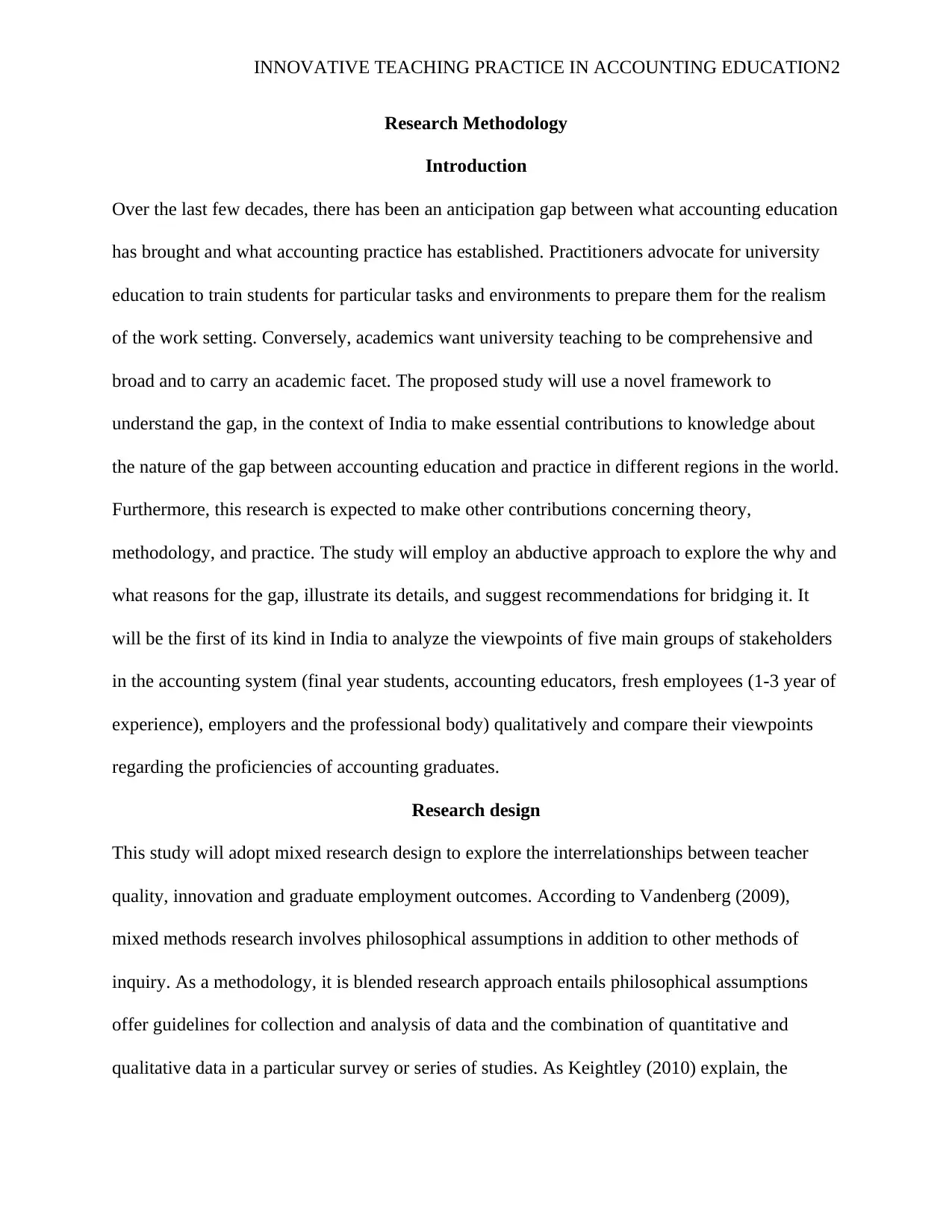
INNOVATIVE TEACHING PRACTICE IN ACCOUNTING EDUCATION2
Research Methodology
Introduction
Over the last few decades, there has been an anticipation gap between what accounting education
has brought and what accounting practice has established. Practitioners advocate for university
education to train students for particular tasks and environments to prepare them for the realism
of the work setting. Conversely, academics want university teaching to be comprehensive and
broad and to carry an academic facet. The proposed study will use a novel framework to
understand the gap, in the context of India to make essential contributions to knowledge about
the nature of the gap between accounting education and practice in different regions in the world.
Furthermore, this research is expected to make other contributions concerning theory,
methodology, and practice. The study will employ an abductive approach to explore the why and
what reasons for the gap, illustrate its details, and suggest recommendations for bridging it. It
will be the first of its kind in India to analyze the viewpoints of five main groups of stakeholders
in the accounting system (final year students, accounting educators, fresh employees (1-3 year of
experience), employers and the professional body) qualitatively and compare their viewpoints
regarding the proficiencies of accounting graduates.
Research design
This study will adopt mixed research design to explore the interrelationships between teacher
quality, innovation and graduate employment outcomes. According to Vandenberg (2009),
mixed methods research involves philosophical assumptions in addition to other methods of
inquiry. As a methodology, it is blended research approach entails philosophical assumptions
offer guidelines for collection and analysis of data and the combination of quantitative and
qualitative data in a particular survey or series of studies. As Keightley (2010) explain, the
Research Methodology
Introduction
Over the last few decades, there has been an anticipation gap between what accounting education
has brought and what accounting practice has established. Practitioners advocate for university
education to train students for particular tasks and environments to prepare them for the realism
of the work setting. Conversely, academics want university teaching to be comprehensive and
broad and to carry an academic facet. The proposed study will use a novel framework to
understand the gap, in the context of India to make essential contributions to knowledge about
the nature of the gap between accounting education and practice in different regions in the world.
Furthermore, this research is expected to make other contributions concerning theory,
methodology, and practice. The study will employ an abductive approach to explore the why and
what reasons for the gap, illustrate its details, and suggest recommendations for bridging it. It
will be the first of its kind in India to analyze the viewpoints of five main groups of stakeholders
in the accounting system (final year students, accounting educators, fresh employees (1-3 year of
experience), employers and the professional body) qualitatively and compare their viewpoints
regarding the proficiencies of accounting graduates.
Research design
This study will adopt mixed research design to explore the interrelationships between teacher
quality, innovation and graduate employment outcomes. According to Vandenberg (2009),
mixed methods research involves philosophical assumptions in addition to other methods of
inquiry. As a methodology, it is blended research approach entails philosophical assumptions
offer guidelines for collection and analysis of data and the combination of quantitative and
qualitative data in a particular survey or series of studies. As Keightley (2010) explain, the
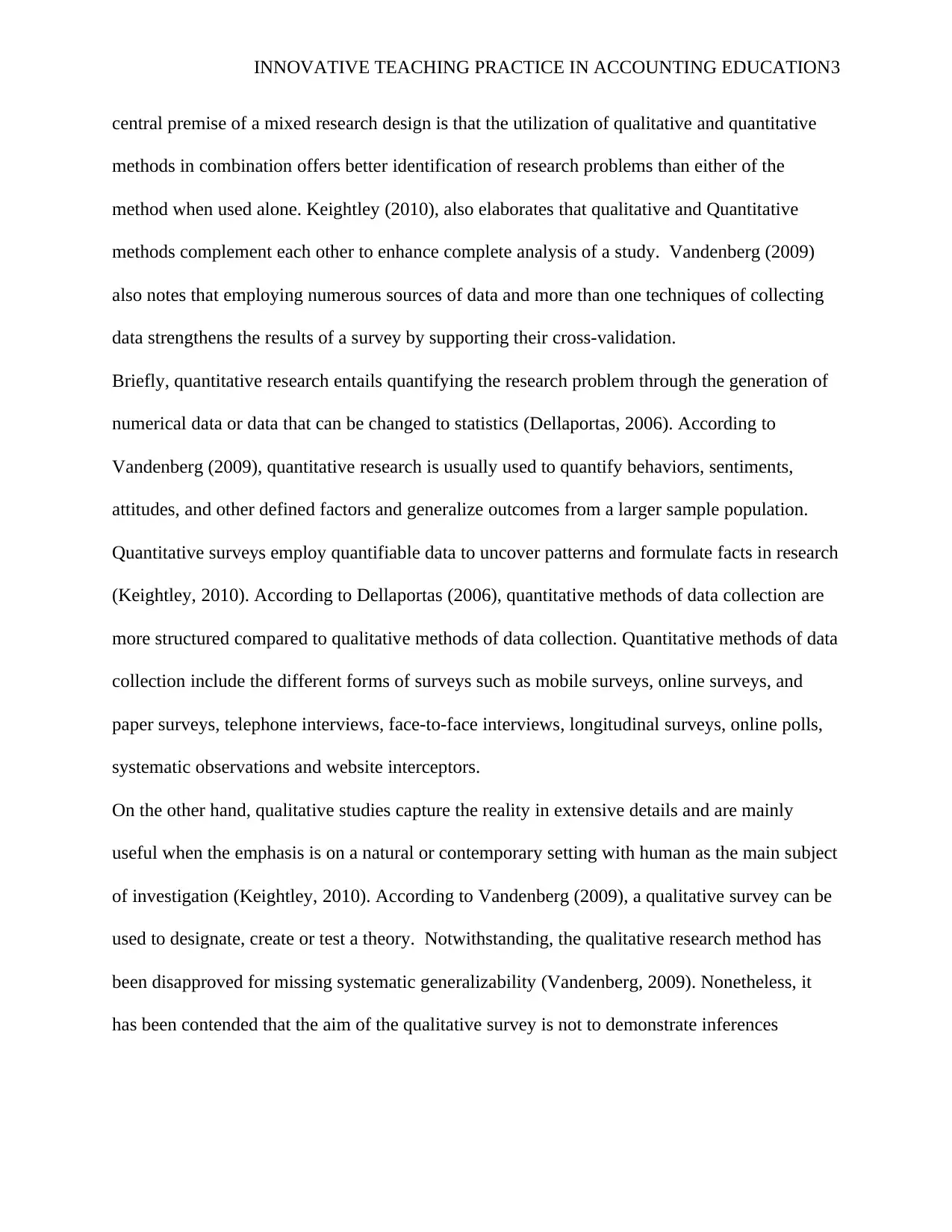
INNOVATIVE TEACHING PRACTICE IN ACCOUNTING EDUCATION3
central premise of a mixed research design is that the utilization of qualitative and quantitative
methods in combination offers better identification of research problems than either of the
method when used alone. Keightley (2010), also elaborates that qualitative and Quantitative
methods complement each other to enhance complete analysis of a study. Vandenberg (2009)
also notes that employing numerous sources of data and more than one techniques of collecting
data strengthens the results of a survey by supporting their cross-validation.
Briefly, quantitative research entails quantifying the research problem through the generation of
numerical data or data that can be changed to statistics (Dellaportas, 2006). According to
Vandenberg (2009), quantitative research is usually used to quantify behaviors, sentiments,
attitudes, and other defined factors and generalize outcomes from a larger sample population.
Quantitative surveys employ quantifiable data to uncover patterns and formulate facts in research
(Keightley, 2010). According to Dellaportas (2006), quantitative methods of data collection are
more structured compared to qualitative methods of data collection. Quantitative methods of data
collection include the different forms of surveys such as mobile surveys, online surveys, and
paper surveys, telephone interviews, face-to-face interviews, longitudinal surveys, online polls,
systematic observations and website interceptors.
On the other hand, qualitative studies capture the reality in extensive details and are mainly
useful when the emphasis is on a natural or contemporary setting with human as the main subject
of investigation (Keightley, 2010). According to Vandenberg (2009), a qualitative survey can be
used to designate, create or test a theory. Notwithstanding, the qualitative research method has
been disapproved for missing systematic generalizability (Vandenberg, 2009). Nonetheless, it
has been contended that the aim of the qualitative survey is not to demonstrate inferences
central premise of a mixed research design is that the utilization of qualitative and quantitative
methods in combination offers better identification of research problems than either of the
method when used alone. Keightley (2010), also elaborates that qualitative and Quantitative
methods complement each other to enhance complete analysis of a study. Vandenberg (2009)
also notes that employing numerous sources of data and more than one techniques of collecting
data strengthens the results of a survey by supporting their cross-validation.
Briefly, quantitative research entails quantifying the research problem through the generation of
numerical data or data that can be changed to statistics (Dellaportas, 2006). According to
Vandenberg (2009), quantitative research is usually used to quantify behaviors, sentiments,
attitudes, and other defined factors and generalize outcomes from a larger sample population.
Quantitative surveys employ quantifiable data to uncover patterns and formulate facts in research
(Keightley, 2010). According to Dellaportas (2006), quantitative methods of data collection are
more structured compared to qualitative methods of data collection. Quantitative methods of data
collection include the different forms of surveys such as mobile surveys, online surveys, and
paper surveys, telephone interviews, face-to-face interviews, longitudinal surveys, online polls,
systematic observations and website interceptors.
On the other hand, qualitative studies capture the reality in extensive details and are mainly
useful when the emphasis is on a natural or contemporary setting with human as the main subject
of investigation (Keightley, 2010). According to Vandenberg (2009), a qualitative survey can be
used to designate, create or test a theory. Notwithstanding, the qualitative research method has
been disapproved for missing systematic generalizability (Vandenberg, 2009). Nonetheless, it
has been contended that the aim of the qualitative survey is not to demonstrate inferences
⊘ This is a preview!⊘
Do you want full access?
Subscribe today to unlock all pages.

Trusted by 1+ million students worldwide
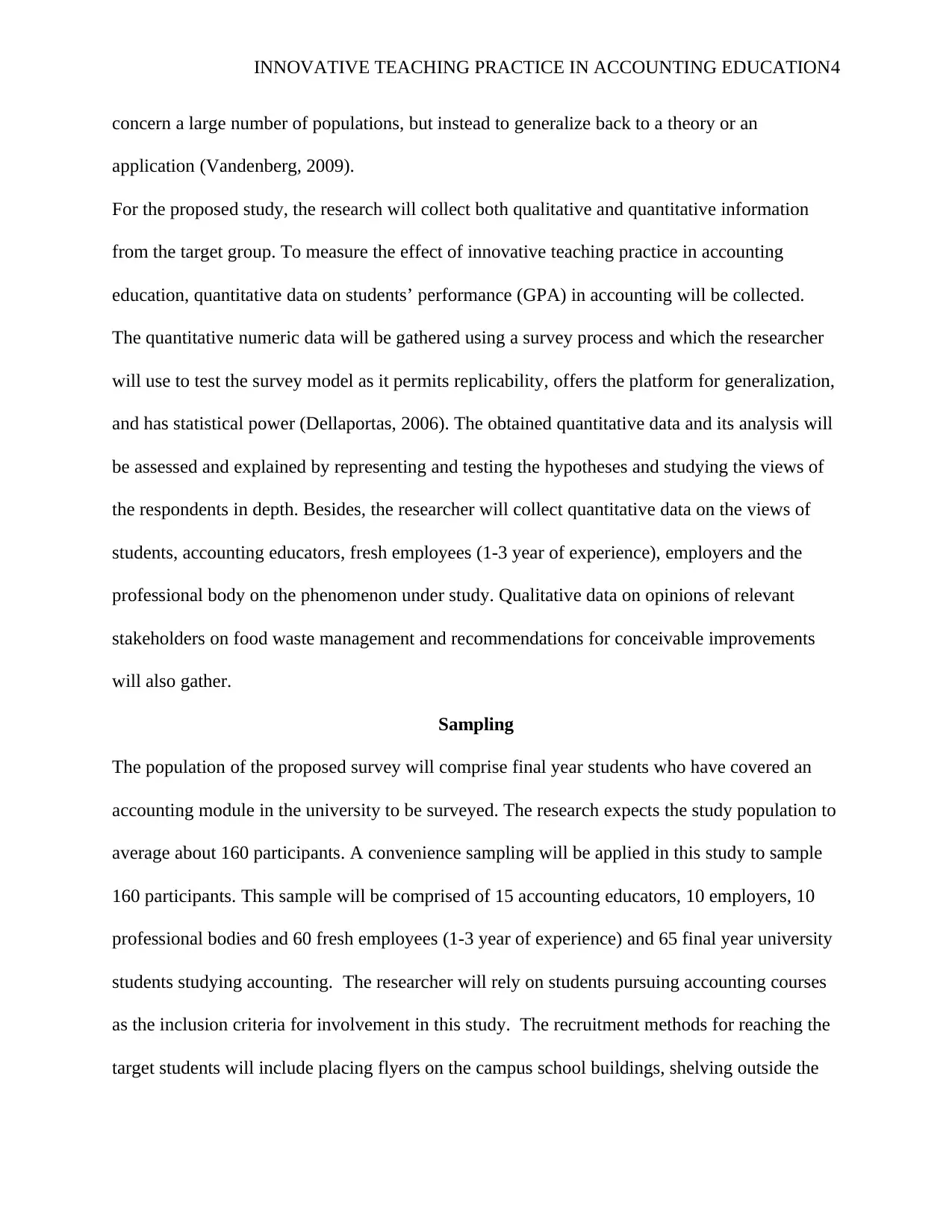
INNOVATIVE TEACHING PRACTICE IN ACCOUNTING EDUCATION4
concern a large number of populations, but instead to generalize back to a theory or an
application (Vandenberg, 2009).
For the proposed study, the research will collect both qualitative and quantitative information
from the target group. To measure the effect of innovative teaching practice in accounting
education, quantitative data on students’ performance (GPA) in accounting will be collected.
The quantitative numeric data will be gathered using a survey process and which the researcher
will use to test the survey model as it permits replicability, offers the platform for generalization,
and has statistical power (Dellaportas, 2006). The obtained quantitative data and its analysis will
be assessed and explained by representing and testing the hypotheses and studying the views of
the respondents in depth. Besides, the researcher will collect quantitative data on the views of
students, accounting educators, fresh employees (1-3 year of experience), employers and the
professional body on the phenomenon under study. Qualitative data on opinions of relevant
stakeholders on food waste management and recommendations for conceivable improvements
will also gather.
Sampling
The population of the proposed survey will comprise final year students who have covered an
accounting module in the university to be surveyed. The research expects the study population to
average about 160 participants. A convenience sampling will be applied in this study to sample
160 participants. This sample will be comprised of 15 accounting educators, 10 employers, 10
professional bodies and 60 fresh employees (1-3 year of experience) and 65 final year university
students studying accounting. The researcher will rely on students pursuing accounting courses
as the inclusion criteria for involvement in this study. The recruitment methods for reaching the
target students will include placing flyers on the campus school buildings, shelving outside the
concern a large number of populations, but instead to generalize back to a theory or an
application (Vandenberg, 2009).
For the proposed study, the research will collect both qualitative and quantitative information
from the target group. To measure the effect of innovative teaching practice in accounting
education, quantitative data on students’ performance (GPA) in accounting will be collected.
The quantitative numeric data will be gathered using a survey process and which the researcher
will use to test the survey model as it permits replicability, offers the platform for generalization,
and has statistical power (Dellaportas, 2006). The obtained quantitative data and its analysis will
be assessed and explained by representing and testing the hypotheses and studying the views of
the respondents in depth. Besides, the researcher will collect quantitative data on the views of
students, accounting educators, fresh employees (1-3 year of experience), employers and the
professional body on the phenomenon under study. Qualitative data on opinions of relevant
stakeholders on food waste management and recommendations for conceivable improvements
will also gather.
Sampling
The population of the proposed survey will comprise final year students who have covered an
accounting module in the university to be surveyed. The research expects the study population to
average about 160 participants. A convenience sampling will be applied in this study to sample
160 participants. This sample will be comprised of 15 accounting educators, 10 employers, 10
professional bodies and 60 fresh employees (1-3 year of experience) and 65 final year university
students studying accounting. The researcher will rely on students pursuing accounting courses
as the inclusion criteria for involvement in this study. The recruitment methods for reaching the
target students will include placing flyers on the campus school buildings, shelving outside the
Paraphrase This Document
Need a fresh take? Get an instant paraphrase of this document with our AI Paraphraser

INNOVATIVE TEACHING PRACTICE IN ACCOUNTING EDUCATION5
library, and contacting directly vice-chancellors from the University of Study. This will be
conducted by the researcher to warrant that the sample of the study will be representative enough
to draw relevant conclusions
Data Collection
Before rolling out the research to the eligible participants, the investigator will obtain an
authorization letter from the University of studying to conduct the study. The surveys data will
be gathered from June 2015 to June 2019 in the xxx District in India. The researcher will
organize for interviews with 15 accounting educators in the specific regions in India. To evaluate
the feasibility of the study, the investigator will collect and review both secondary and primary
data. For secondary data, data will be collected from websites, newspaper articles, PDFs, books,
and electronic sources like peer-reviewed journals. For primary data, interviews will be
conducted from June 2015 to June 2019. The period of each interview will be roughly 30
minutes. The eligible participants will be given a print of the interview procedure in advance. In
mid-June 2018, the researcher will randomly distribute the hard copies of the survey tool to the
selected participants to be completed in less than 20 by answering all 30 questions in the survey
questionnaire. Through conducting face to face interviews and administering the survey tools
directly to the eligible respondents, the researcher will be able to obtain information challenges
that are faced by students and other stakeholders concerning their academic success on
accounting education.
Validity and Reliability
As the population of the study will comprise students in university among other people, the
researcher will use some students to a pilot the study to assess the reliability and create validity
of the survey tool (Sandelowski et al., 2011). In addition, the researcher will subject the collected
library, and contacting directly vice-chancellors from the University of Study. This will be
conducted by the researcher to warrant that the sample of the study will be representative enough
to draw relevant conclusions
Data Collection
Before rolling out the research to the eligible participants, the investigator will obtain an
authorization letter from the University of studying to conduct the study. The surveys data will
be gathered from June 2015 to June 2019 in the xxx District in India. The researcher will
organize for interviews with 15 accounting educators in the specific regions in India. To evaluate
the feasibility of the study, the investigator will collect and review both secondary and primary
data. For secondary data, data will be collected from websites, newspaper articles, PDFs, books,
and electronic sources like peer-reviewed journals. For primary data, interviews will be
conducted from June 2015 to June 2019. The period of each interview will be roughly 30
minutes. The eligible participants will be given a print of the interview procedure in advance. In
mid-June 2018, the researcher will randomly distribute the hard copies of the survey tool to the
selected participants to be completed in less than 20 by answering all 30 questions in the survey
questionnaire. Through conducting face to face interviews and administering the survey tools
directly to the eligible respondents, the researcher will be able to obtain information challenges
that are faced by students and other stakeholders concerning their academic success on
accounting education.
Validity and Reliability
As the population of the study will comprise students in university among other people, the
researcher will use some students to a pilot the study to assess the reliability and create validity
of the survey tool (Sandelowski et al., 2011). In addition, the researcher will subject the collected
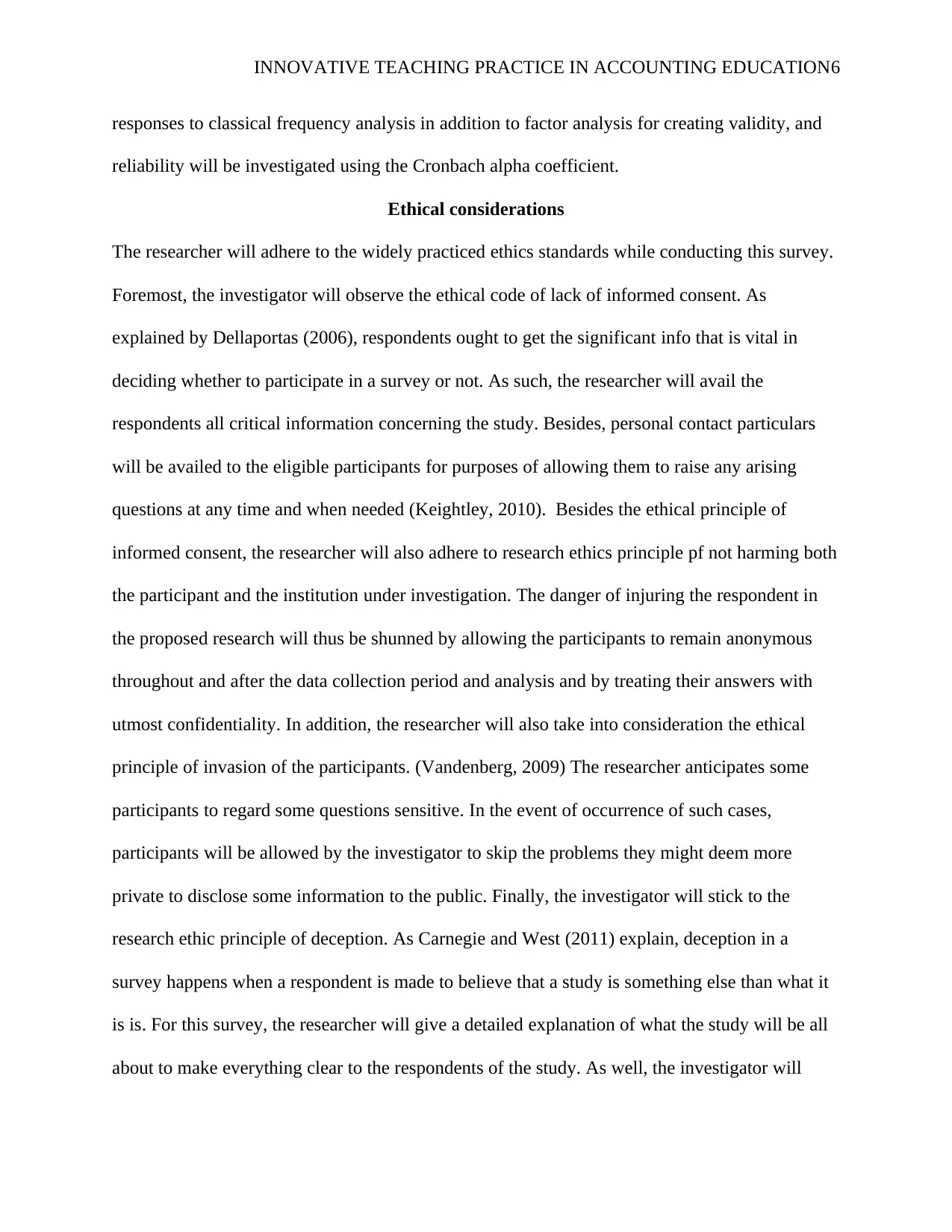
INNOVATIVE TEACHING PRACTICE IN ACCOUNTING EDUCATION6
responses to classical frequency analysis in addition to factor analysis for creating validity, and
reliability will be investigated using the Cronbach alpha coefficient.
Ethical considerations
The researcher will adhere to the widely practiced ethics standards while conducting this survey.
Foremost, the investigator will observe the ethical code of lack of informed consent. As
explained by Dellaportas (2006), respondents ought to get the significant info that is vital in
deciding whether to participate in a survey or not. As such, the researcher will avail the
respondents all critical information concerning the study. Besides, personal contact particulars
will be availed to the eligible participants for purposes of allowing them to raise any arising
questions at any time and when needed (Keightley, 2010). Besides the ethical principle of
informed consent, the researcher will also adhere to research ethics principle pf not harming both
the participant and the institution under investigation. The danger of injuring the respondent in
the proposed research will thus be shunned by allowing the participants to remain anonymous
throughout and after the data collection period and analysis and by treating their answers with
utmost confidentiality. In addition, the researcher will also take into consideration the ethical
principle of invasion of the participants. (Vandenberg, 2009) The researcher anticipates some
participants to regard some questions sensitive. In the event of occurrence of such cases,
participants will be allowed by the investigator to skip the problems they might deem more
private to disclose some information to the public. Finally, the investigator will stick to the
research ethic principle of deception. As Carnegie and West (2011) explain, deception in a
survey happens when a respondent is made to believe that a study is something else than what it
is is. For this survey, the researcher will give a detailed explanation of what the study will be all
about to make everything clear to the respondents of the study. As well, the investigator will
responses to classical frequency analysis in addition to factor analysis for creating validity, and
reliability will be investigated using the Cronbach alpha coefficient.
Ethical considerations
The researcher will adhere to the widely practiced ethics standards while conducting this survey.
Foremost, the investigator will observe the ethical code of lack of informed consent. As
explained by Dellaportas (2006), respondents ought to get the significant info that is vital in
deciding whether to participate in a survey or not. As such, the researcher will avail the
respondents all critical information concerning the study. Besides, personal contact particulars
will be availed to the eligible participants for purposes of allowing them to raise any arising
questions at any time and when needed (Keightley, 2010). Besides the ethical principle of
informed consent, the researcher will also adhere to research ethics principle pf not harming both
the participant and the institution under investigation. The danger of injuring the respondent in
the proposed research will thus be shunned by allowing the participants to remain anonymous
throughout and after the data collection period and analysis and by treating their answers with
utmost confidentiality. In addition, the researcher will also take into consideration the ethical
principle of invasion of the participants. (Vandenberg, 2009) The researcher anticipates some
participants to regard some questions sensitive. In the event of occurrence of such cases,
participants will be allowed by the investigator to skip the problems they might deem more
private to disclose some information to the public. Finally, the investigator will stick to the
research ethic principle of deception. As Carnegie and West (2011) explain, deception in a
survey happens when a respondent is made to believe that a study is something else than what it
is is. For this survey, the researcher will give a detailed explanation of what the study will be all
about to make everything clear to the respondents of the study. As well, the investigator will
⊘ This is a preview!⊘
Do you want full access?
Subscribe today to unlock all pages.

Trusted by 1+ million students worldwide
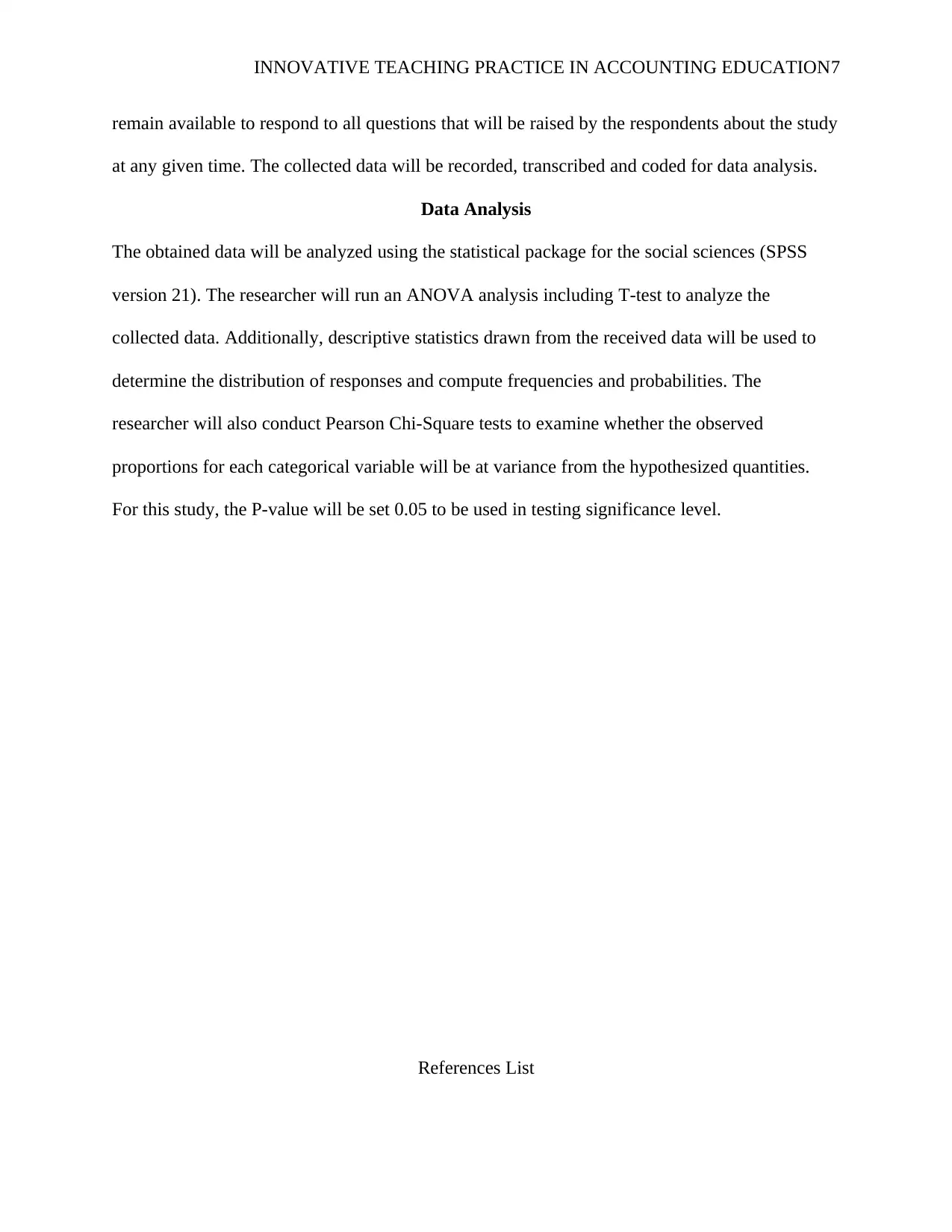
INNOVATIVE TEACHING PRACTICE IN ACCOUNTING EDUCATION7
remain available to respond to all questions that will be raised by the respondents about the study
at any given time. The collected data will be recorded, transcribed and coded for data analysis.
Data Analysis
The obtained data will be analyzed using the statistical package for the social sciences (SPSS
version 21). The researcher will run an ANOVA analysis including T-test to analyze the
collected data. Additionally, descriptive statistics drawn from the received data will be used to
determine the distribution of responses and compute frequencies and probabilities. The
researcher will also conduct Pearson Chi-Square tests to examine whether the observed
proportions for each categorical variable will be at variance from the hypothesized quantities.
For this study, the P-value will be set 0.05 to be used in testing significance level.
References List
remain available to respond to all questions that will be raised by the respondents about the study
at any given time. The collected data will be recorded, transcribed and coded for data analysis.
Data Analysis
The obtained data will be analyzed using the statistical package for the social sciences (SPSS
version 21). The researcher will run an ANOVA analysis including T-test to analyze the
collected data. Additionally, descriptive statistics drawn from the received data will be used to
determine the distribution of responses and compute frequencies and probabilities. The
researcher will also conduct Pearson Chi-Square tests to examine whether the observed
proportions for each categorical variable will be at variance from the hypothesized quantities.
For this study, the P-value will be set 0.05 to be used in testing significance level.
References List
Paraphrase This Document
Need a fresh take? Get an instant paraphrase of this document with our AI Paraphraser
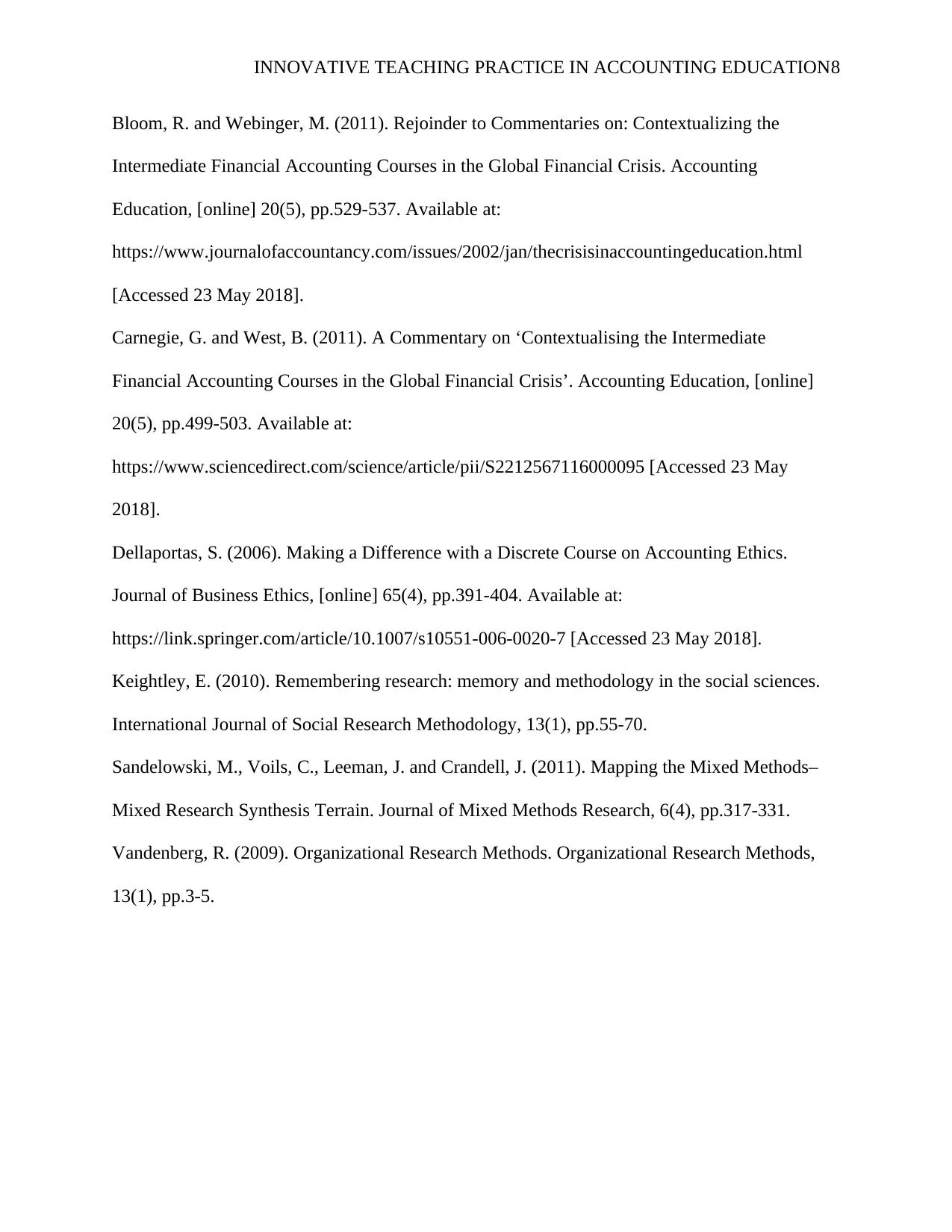
INNOVATIVE TEACHING PRACTICE IN ACCOUNTING EDUCATION8
Bloom, R. and Webinger, M. (2011). Rejoinder to Commentaries on: Contextualizing the
Intermediate Financial Accounting Courses in the Global Financial Crisis. Accounting
Education, [online] 20(5), pp.529-537. Available at:
https://www.journalofaccountancy.com/issues/2002/jan/thecrisisinaccountingeducation.html
[Accessed 23 May 2018].
Carnegie, G. and West, B. (2011). A Commentary on ‘Contextualising the Intermediate
Financial Accounting Courses in the Global Financial Crisis’. Accounting Education, [online]
20(5), pp.499-503. Available at:
https://www.sciencedirect.com/science/article/pii/S2212567116000095 [Accessed 23 May
2018].
Dellaportas, S. (2006). Making a Difference with a Discrete Course on Accounting Ethics.
Journal of Business Ethics, [online] 65(4), pp.391-404. Available at:
https://link.springer.com/article/10.1007/s10551-006-0020-7 [Accessed 23 May 2018].
Keightley, E. (2010). Remembering research: memory and methodology in the social sciences.
International Journal of Social Research Methodology, 13(1), pp.55-70.
Sandelowski, M., Voils, C., Leeman, J. and Crandell, J. (2011). Mapping the Mixed Methods–
Mixed Research Synthesis Terrain. Journal of Mixed Methods Research, 6(4), pp.317-331.
Vandenberg, R. (2009). Organizational Research Methods. Organizational Research Methods,
13(1), pp.3-5.
Bloom, R. and Webinger, M. (2011). Rejoinder to Commentaries on: Contextualizing the
Intermediate Financial Accounting Courses in the Global Financial Crisis. Accounting
Education, [online] 20(5), pp.529-537. Available at:
https://www.journalofaccountancy.com/issues/2002/jan/thecrisisinaccountingeducation.html
[Accessed 23 May 2018].
Carnegie, G. and West, B. (2011). A Commentary on ‘Contextualising the Intermediate
Financial Accounting Courses in the Global Financial Crisis’. Accounting Education, [online]
20(5), pp.499-503. Available at:
https://www.sciencedirect.com/science/article/pii/S2212567116000095 [Accessed 23 May
2018].
Dellaportas, S. (2006). Making a Difference with a Discrete Course on Accounting Ethics.
Journal of Business Ethics, [online] 65(4), pp.391-404. Available at:
https://link.springer.com/article/10.1007/s10551-006-0020-7 [Accessed 23 May 2018].
Keightley, E. (2010). Remembering research: memory and methodology in the social sciences.
International Journal of Social Research Methodology, 13(1), pp.55-70.
Sandelowski, M., Voils, C., Leeman, J. and Crandell, J. (2011). Mapping the Mixed Methods–
Mixed Research Synthesis Terrain. Journal of Mixed Methods Research, 6(4), pp.317-331.
Vandenberg, R. (2009). Organizational Research Methods. Organizational Research Methods,
13(1), pp.3-5.
1 out of 8
Related Documents
Your All-in-One AI-Powered Toolkit for Academic Success.
+13062052269
info@desklib.com
Available 24*7 on WhatsApp / Email
![[object Object]](/_next/static/media/star-bottom.7253800d.svg)
Unlock your academic potential
Copyright © 2020–2025 A2Z Services. All Rights Reserved. Developed and managed by ZUCOL.





